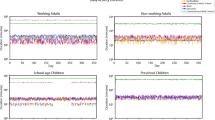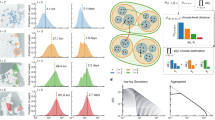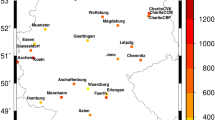Abstract
Human exposure to particulate matter and other environmental species is difficult to estimate in large populations. Individuals can encounter significant and acute variations in exposure over small spatiotemporal scales. Exposure is strongly tied to both the environmental and activity contexts that individuals experience. Here we present the development of an agent-based model to simulate human exposure at high spatiotemporal resolutions. The model is based on simulated activity and location trajectories on a per-person basis for large geographical areas. We demonstrate that the model can successfully estimate trajectories and that activity patterns have been validated against traffic patterns and that can be integrated with exposure-agent geographical distributions to estimate total human exposure.
This is a preview of subscription content, access via your institution
Access options
Subscribe to this journal
Receive 6 print issues and online access
$259.00 per year
only $43.17 per issue
Buy this article
- Purchase on Springer Link
- Instant access to full article PDF
Prices may be subject to local taxes which are calculated during checkout








Similar content being viewed by others
References
Brauer M, Hoek G, Smit HA, de Jongste JC, Gerritsen J, Postma DS, et al. Air pollution and development of asthma, allergy and infections in a birth cohort. Eur Respir J. 2007;29:879–88.
Anderson JO, Thundiyil JG, Stolbach A. Clearing the air: a review of the effects of particulate matter air pollution on human health. J Med Toxicol. 2012;8:166–75.
Lu F, Xu D, Cheng Y, Dong S, Guo C, Jiang X, et al. Systematic review and meta-analysis of the adverse health effects of ambient PM2.5 and PM10 pollution in the Chinese population. Environ Res. 2015;136:196–204.
Hadlocon LS, Zhao LY, Bohrer G, Kenny W, Garrity SR, Wang J, et al. Modeling of particulate matter dispersion from a poultry facility using AERMOD. J Air Waste Manag Assoc. 2015;65:206–17.
Colbeck I, Lazaridis M. Aerosols and environmental pollution. Naturwissenschaften. 2010;97:117–31.
Apte JS, Messier KP, Gani S, Brauer M, Kirchstetter TW, Lunden MM, et al. High-resolution air pollution mapping with google street view cars: exploiting big data. Environ Sci Technol. 2017;51:6999–7008.
Mitchell LE, Crosman ET, Jacques AA, Fasoli B, Leclair-Marzolf L, Horel J, et al. Monitoring of greenhouse gases and pollutants across an urban area using a light-rail public transit platform. Atmos Environ. 2018;187:9–23.
Baker KR, Foley KM. A nonlinear regression model estimating single source concentrations of primary and secondarily formed PM2.5. Atmos Environ. 2011;45:3758–67.
Cyrys J, Pitz M, Bischof W, Wichmann HE, Heinrich J. Relationship between indoor and outdoor levels of fine particle mass, particle number concentrations and black smoke under different ventilation conditions. J Expo Anal Environ Epidemiol. 2004;14:275.
Lundrigan P, Min KT, Patwari N, Kasera SK, Kelly K, Moore J, et al. EpiFi: an in-home sensor network architecture for epidemiological studies. CoRR. 2017;abs/1709.02233.
Meseck K, Jankowska MM, Schipperijn J, Natarajan L, Godbole S, Carlson J, et al. Is missing geographic positioning system data in accelerometry studies a problem, and is imputation the solution? Geospat Health. 2016;11:403.
Li Z, Che W, Frey HC, Lau AKH, Lin C. Characterization of PM2.5 exposure concentration in transport microenvironments using portable monitors. Environ Pollut. 2017;228:433–42.
Steinle S, Reis S, Sabel CE, Semple S, Twigg MM, Braban CF, et al. Personal exposure monitoring of PM2.5 in indoor and outdoor microenvironments. Sci Total Environ. 2015;508:383–94.
Klepeis NE, Nelson WC, Ott WR, Robinson JP, Tsang AM, Switzer P, et al. The National Human Activity Pattern Survey (NHAPS): a resource for assessing exposure to environmental pollutants. J Expo Anal Environ Epidemiol. 2001;11:231.
Dias D, Tchepel O. Spatial and temporal dynamics in air pollution exposure assessment. Int J Environ Res Public Health. 2018;15:558.
Statistics USDoLBotL. American Time Use Survey, 2015 [United States]. 2016.
U.S. EPA. CHAD user’s guide: extracting human activity information from CHAD on the PC. In: Agency USEP, editor. Washington; 2002.
National Household Travel Survey, 2020. https://nhts.ornl.gov/.
Herder E, Siehndel P, Kawase R, editors. Predicting user locations and trajectories BT—user modeling, adaptation, and personalization. Cham: Springer International Publishing; 2014.
Zhou Z, Chen X, Chung YC, He Z, Han TX, Keller JM. Activity analysis, summarization, and visualization for indoor human activity monitoring. IEEE Trans Circuits Syst Video Technol. 2008;18:1489–98.
Redmond DP, Hegge FW. Observations on the design and specification of a wrist-worn human activity monitoring system. Behav Res Methods, Instrum Comput. 1985;17:659–69.
Bradley M, Bowman JL, Griesenbeck B. SACSIM: An applied activity-based model system with fine-level spatial and temporal resolution. J Choice Model. 2010;3:5–31.
Bhat CR, Guo JY, Srinivasan S, Sivakumar A. Comprehensive econometric microsimulator for daily activity-travel patterns. Transp Res Record. 2004;1894:57–66.
Bellemans T, Kochan B, Janssens D, Wets G, Arentze T, Timmermans H. Implementation framework and development trajectory of FEATHERS activity-based simulation platform. Transp Res Rec. 2010;2175:111–9.
ATR Hourly Volume Files, 2014. Utah Department of Transportation; 2015.
Pendyala RM, Kitamura R, Reddy DVGP. Application of an activity-based travel-demand model incorporating a rule-based algorithm. Environ Plan B: Plan Des. 1998;25:753–72.
Arentze T, Hofman F, van Mourik H, Timmermans H. ALBATROSS: multiagent, rule-based model of activity pattern decisions. Transp Res Rec. 2000;1706:136–44.
Brandon N, Dionisio KL, Isaacs K, Tornero-Velez R, Kapraun D, Setzer RW, et al. Simulating exposure-related behaviors using agent-based models embedded with needs-based artificial intelligence. J Expo Sci Environ Epidemiol. 2018;30:184–93.
Gurram S, Stuart AL, Pinjari AR. Agent-based modeling to estimate exposures to urban air pollution from transportation: exposure disparities and impacts of high-resolution data. Comput, Environ Urban Syst. 2019;75:22–34.
Hatzopoulou M, Miller EJ. Linking an activity-based travel demand model with traffic emission and dispersion models: transport’s contribution to air pollution in Toronto. Transp Res Part D: Transp Environ. 2010;15:315–25.
Beckx C, Int Panis L, Arentze T, Janssens D, Torfs R, Broekx S, et al. A dynamic activity-based population modelling approach to evaluate exposure to air pollution: methods and application to a Dutch urban area. Environ Impact Assess Rev. 2009;29:179–85.
2015 TIGER/Line Shapefiles (machine-readable data files). Washington, DC: United States Census Bureau; 2015. Available at https://www.census.gov/geographies/mapping-files/time-series/geo/tiger-line-file.html.
2015 American Community Survey (machine-readable data files). United States Census Bureau/American FactFinder; 2016. Available at https://factfinder.census.gov/faces/nav/jsf/pages/index.xhtml.
2010 Censes demographic Profile summary File (machine-readable data files). United States Census Bureau/American FactFinder; 2011. Available at https://www.census.gov/prod/cen2010/doc/dpsf.pdf.
Utah Data (website). State of Utah; 2017. Available at https://www.utah.gov/data/.
2015 LEHD Origin-Destination Employment Statistics (LODES) Dataset Version 7.3 (machine-readable data files). United States Census Bureau; 2016. Available at https://lehd.ces.census.gov/data/lodes/LODES7/LODESTechDoc7.3.pdf.
Lund A, Gouripeddi R, Facelli J. Classification and generation of activity sequences for spatiotemporal modeling of human populations; 2019. Peprint at http://arxiv.org/abs/191105476.
Luxen D, Vetter C (eds.). Real-time routing with OpenStreetMap data. New York: ACM; 2011.
Anaconda Python. Continuuum Analytics, Inc. (dba Anaconda, Inc.); 2017. Available at https://www.anaconda.com/.
McKinney W. Pandas: a Foundational Python Library for Data Analysis and Statistics.
McKinney W. (ed.). Data structures for statistical computing in Python; 2010.
Pedregosa F, Varoquaux G, Gramfort A, Michel V, Thirion B, Grisel O, et al. Scikit-learn: machine Learning in {P}ython. J Mach Learn Res. 2011;12:2825–30.
Whiteman CD. Frequently asked Questions about Wintertime PM2.5 Pollution in Utah’s Salt Lake Valley; 2017.
Gurram S, Stuart AL, Pinjari AR. Impacts of travel activity and urbanicity on exposures to ambient oxides of nitrogen and on exposure disparities. Air Qual, Atmos Health. 2015;8:97–114.
Acknowledgements
We thank members of Professor John Horel’s group at the Department of Atmospheric Sciences for providing their expertise and for developing the PM 2.5 statistical model. The research reported in this publication was supported (in part or in full) by NIBIB/NIH under Award Number 1U54EB021973 and NCATS/NIH under Award Number UL1TR001067. Computational resources were provided by the Utah Center for High Performance Computing, which has been partially funded by the NIH Shared Instrumentation Grant 1S10OD021644-01A1. Map data copyrighted by OpenStreetMap contributors and is available from https://www.openstreetmap.org.
Author information
Authors and Affiliations
Corresponding author
Ethics declarations
Conflict of interest
The authors declare that they have no conflict of interest.
Additional information
Publisher’s note Springer Nature remains neutral with regard to jurisdictional claims in published maps and institutional affiliations.
Supplementary information
Rights and permissions
About this article
Cite this article
Lund, A.M., Gouripeddi, R. & Facelli, J.C. STHAM: an agent based model for simulating human exposure across high resolution spatiotemporal domains. J Expo Sci Environ Epidemiol 30, 459–468 (2020). https://doi.org/10.1038/s41370-020-0216-4
Received:
Revised:
Accepted:
Published:
Issue Date:
DOI: https://doi.org/10.1038/s41370-020-0216-4



